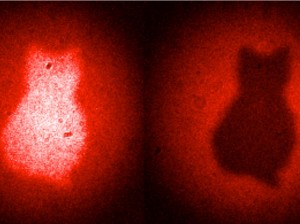This week, Critical Link is in Stuttgart, Germany, for Vision, the International Machine Vision Trade Fair.
So while I’m always thinking about things related to vision, this week I’m really thin king about things related to vision. And while I was thinking about things related to vision, I was also catching up on my reading, and came across an interesting article last August in OPLI, Quantum Physics Enabled Revolutionary Imaging Method.
king about things related to vision. And while I was thinking about things related to vision, I was also catching up on my reading, and came across an interesting article last August in OPLI, Quantum Physics Enabled Revolutionary Imaging Method.
The article talks about an experimental quantum physics method of imaging objects in extremely low/no light situations, and in this case a situation where the sensor never actually “sees” the object at all, but is still able to image it.
“In general, to obtain an image of an object one has to illuminate it with a light beam and use a camera to sense the light that is either scattered or transmitted through that object. The type of light used to shine onto the object depends on the properties that one would like to image. Unfortunately, in many practical situations the ideal type of light for the illumination of the object is one for which cameras do not exist.
“The experiment published in Nature this week for the first time breaks this seemingly self-evident limitation. The object (e.g. the contour of a cat) is illuminated with light that remains undetected. Moreover, the light that forms an image of the cat on the camera never interacts with it.” (Source: OPLI article linked above.)
The suspicion is that they chose a cat (rather than, say, a dog) in a nod to the Schrödinger cat paradox which is that, if you don’t have any outside information one way or another, a cat in a closed box could be both dead an alive at the same time.
Similarly, the new imaging technique relies on a lack of information regarding where the photons are created and which path they take.
We don’t quite get involved in the “no information” scenarios like this experiment, but two of our newest MityCAMs (the MityCAM-B2521F and MityCAM-B1910F) incorporate sCMOS sensors from Fairchild Imaging that offer superior performance in low light applications. If you’re at Vision, we’re demo-ing the MityCAM-B2521F in a low light set up, showing its imaging capabilities at various illumination levels: 1.0 lux, 0.1 lux, and .01 lux. For reference 0.1 lux is less illumination than would be present with a full moon on a clear sky night. A measurement of .01 is getting closer to a moonless night sky. (Almost, if not quite, Schrödinger’s cat-style “no information”.)
——————————————————————————-
Copyright credit for the photo goes to Patricia Enigl, IQOQI
